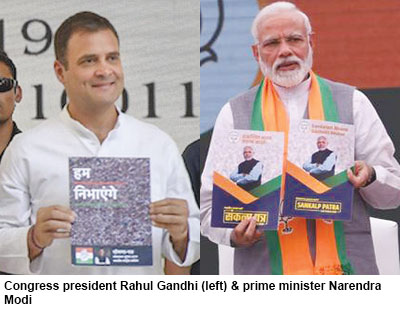 Despite damning start-of-the-year Annual Status of Education Report 2018, QS and Times Higher Education World University Rankings highlighting the pathetic condition of India’s education system from pre-primary to Ph D — and continuous whistle-blowing by EducationWorld for almost two decades — education reform is a peripheral issue in General Election 2019.
Despite damning start-of-the-year Annual Status of Education Report 2018, QS and Times Higher Education World University Rankings highlighting the pathetic condition of India’s education system from pre-primary to Ph D — and continuous whistle-blowing by EducationWorld for almost two decades — education reform is a peripheral issue in General Election 2019.
Although as usual, all political parties make tall promises about greater provision for public education and sundry reforms, in the run-up to the world’s largest and most expensive democratic general election, there’s hardly been any debate on education in the media or political hustings about 21st century India’s broken public education system defined by chronic teacher shortages compounded by teacher truancy, crumbling infrastructure, abysmal learning outcomes and continuous exodus of students from public into private education institutions.
“Almost everyone in politics, industry and civil society agrees that mending India’s broken education system is the most critical challenge that will determine whether we have demographic dividend or demographic disaster. But there’s been hardly any debate about reforming the education system from Kg-Ph D. Perhaps political parties feel that since everyone agrees that education is super critical, there is no point in discussing it,” comments Dr. Parth Shah, president of Delhi-based think tank Centre for Civil Society and member of the governing council of the Indian School of Public Policy, Delhi.
Instead, under the agenda set by the ruling Bharatiya Janata Party (BJP) and prime minister Narendra Modi, national security, i.e, developing capability to stymie external (Pakistan-China) and internal (Muslim) terrorism has emerged as a major issue in General Election 2019. But according to Dr. Geeta Menon, professor at the Centre for Early Childhood Development & Research, Jamia Milia Islamia University, Delhi, national security also requires high priority for education. “Good quality public primary-secondary education is a precondition of social cohesion, civic peace, respect for constitutional values and most important, to develop mental safety in the minds of citizens. This is important given that 90 districts are suffering left wing extremism, strife, and other violence. Traumatised youth in these districts need to be brought into mainstream life through education and development of their problem-solving skills,” says Menon.
The sole political party that has made education reform an electoral issue and has invested political capital in education development, is the Aam Aadmi Party (AAP). But with its writ restricted to Delhi where it has been running the state government for the past four years, its message hasn’t reached the masses. “There is a deliberate strategy to ensure that children and citizens remain under-educated. Or else how will be the BJP be able to find support for its divisive politics?” muses Manish Sisodia, AAP leader and Delhi’s education minister.
Promises relating to reform and rejuvenation of the country’s moribund education system made in the manifestos of major political parties have a familiar ring. Front-runner BJP’s sankalp patra (solemn vow) manifesto is silent on the issues of 6 percent of GDP for public education promised in its General Election 2014 manifesto and on extending the ambit of the landmark Right of Children to Free & Compulsory Education (RTE) Act, 2009 (which makes it mandatory for the state to provide free and compulsory elementary (class I-VIII) education to all children in the 6-14 age group), to cover children in secondary (class VIII-X) school as well.
Nothing loath, the Congress party promises to “build the best education system in the world for our students”. It promises to double national expenditure on education, establish an “independent regulatory mechanism” to oversee state and private institutions, a National Commission of Students, strengthen the RTE Act and increase the GER (gross enrollment ratio) in higher education to 40 percent. All this by “making suitable investments and amendments to regulations wherever required”.
All the other national parties pay ritual obeisance to education in their General Election 2019 manifestos. The Samajwadi Party’s manifesto cites the Unicef (sic) Annual Status of Education Report 2015 to the effect that Uttar Pradesh, which it ruled until 2017, “has made impressive moves in primary education in the last-half decade” and trumpets its past achievements including 57 percent literacy rate. The Bahujan Samaj Party and JDU haven’t released their 2019 manifestos. The Communist Party-Marxist (CPM) promises to raise national outlay on education to 6 percent of GDP, universalisation of pre-primary education and to establish a common school system in the highly unlikely event of it being voted to power.
Unfortunately for the world’s largest child and youth population, neither politicians, the academy nor public seem to be interested in seriously discussing or debating education issues.
Autar Nehru (Delhi)























